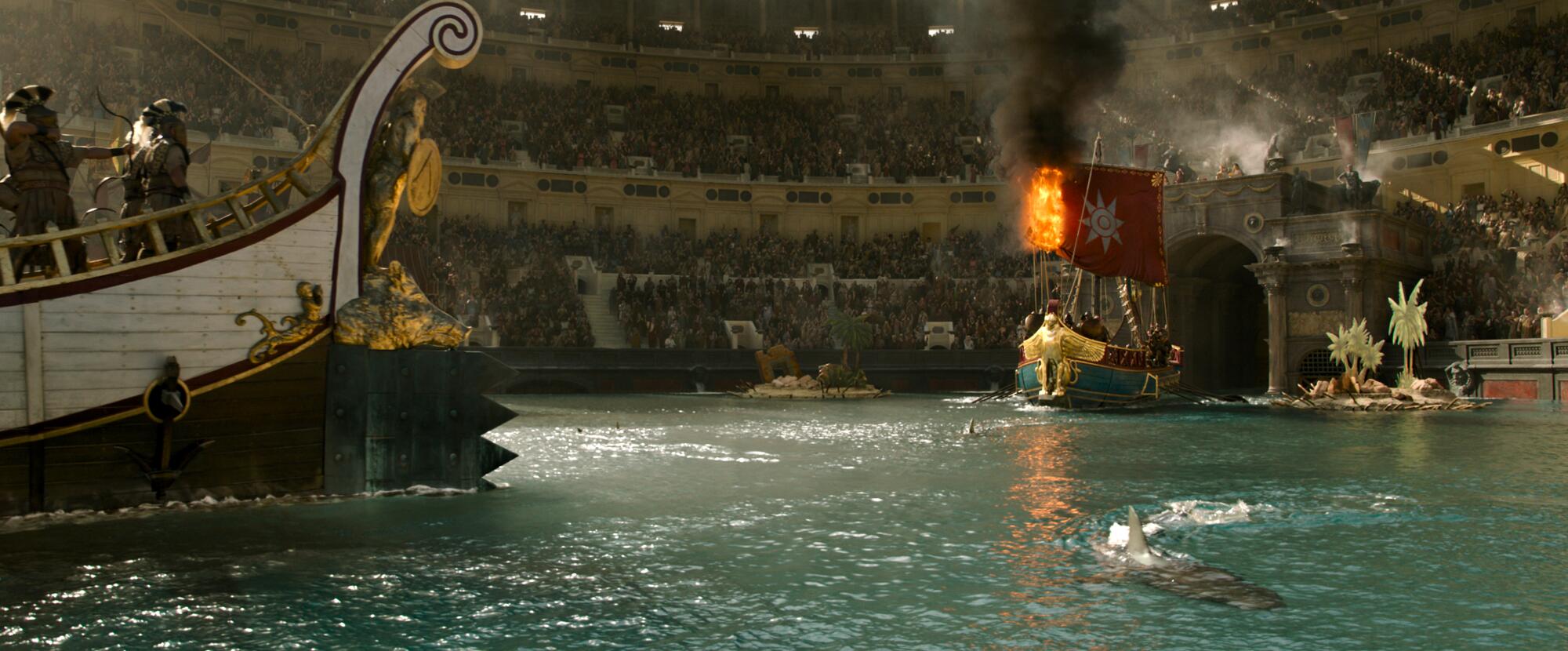
With “Gladiator II,” Ridley Scott returns to the bloody world of his Oscar-winning swords-and-sandals epic. Starring Paul Mescal as Lucius, a young prisoner turned gladiator, this sequel goes bigger and wilder than its predecessor, including monkeys, rhinos and even sharks within its grand action sequences.
To re-create the epic scope of the original film and reimagine it for 2024 audiences, Scott reunited with many of his longtime collaborators. That included special effects supervisor Neil Corbould. Joining him was visual effects supervisor Mark Bakowski.
Unlike Corbould, who’s worked with Scott for decades (he won an Oscar for “Gladiator” and was nominated just last year for the director’s “Napoleon”), Bakowski was excited to work with the famed filmmaker for the first time.
“He’s nuts,” Bakowski says with a laugh via Zoom, about the English director. “But obviously in an excellent way. He shoots quickly, and he likes to move. He’s like, ‘Get me going.’ It’s all rush, rush, rush. It’s great. But it took some getting used to.
“I heard him shout once, ‘I want four donkeys (there might have been a swear word in there) and I want them now!’” Bakowski recalls. “And somehow they turned up.”
Scott’s attention to detail went hand in hand with an instinctual approach to decisions big and small alike. Bakowski points to the choice to include baboons with alopecia in a key scene where Lucius first proves himself a worthy fighter in front of Macrinus (Denzel Washington), a conniving former slave with wild ambitions for the Roman throne.
“They were showing Ridley the baboon because it was an interesting anatomical structure,” Bakowski recalls. “The idea was just to go look at the muscles and sinews that would be a good reference for us when we build it.”
But Scott was immediately taken by this hairless primate, insisting it be the creature Lucius fends off with his bare hands. That scene is but one example where “Gladiator II” used visual effects (and a number of 6-foot-tall stuntmen who stood in for those menacing baboons, a challenge in itself that Bakowski’s team had to contend with) to create the kind of set piece that would have been unthinkable 25 years ago.
Yet “Gladiator” still loomed large in the eyes of all involved — especially when it came to redesigning the film’s most iconic location: the Colosseum.
“When we started, we chatted with this professor of history,” says Bakowski. “He showed us what, according to his interpretation, the Colosseum should be. So we matched the Colosseum to his design. Then we started looking at it in shots, and it didn’t look anything like ‘Gladiator.’ It looks completely different. Basically, it might be right, but it just didn’t look as cool.”
The choice was simple: Lucius would battle in the same Colosseum Russell Crowe’s Maximus had fought in two decades before. In the end, the built set looked almost identical to the one constructed for the 2000 film.
It’s there where Bakowski saw firsthand how a master storyteller like Scott orchestrated some of the film’s most complicated sequences.
“He sets it up like a big symphony,” Bakowski says. “And then sometimes a scene will just roll, like the ship battle. He would roll for minutes upon minutes at a time with, let’s say it’s 10, 12 cameras. He sets up this kind of event, kind of like a little version of a battle. And all these cameras in there just record it.”

That battle takes place in a flooded Colosseum filled with bloodthirsty tiger sharks. There, Lucius and his fellow gladiators must mount a full-scale attack on a warring ship for the entertainment of thousands of Romans watching, including its unhinged sibling emperors, Geta and Caracalla (Joseph Quinn and Fred Hechinger).
“I’ve never seen anything like it,” Bakowski says. “It’s quite close in terms of the energy. It’s not crafted to a lens. The lenses all fit around the action.”
The crackling authenticity such shots create proved a welcome challenge for the entire “Gladiator II” crew. Especially because the original plan for how that naval battle was to be shot had to be scrapped.
“The actors’ strike happened right in the middle of shooting,” Bakowski notes. “We had this week and a half where all the actors had gone, but the stunties were still there because they weren’t SAG. So we had this time. And Ridley was like, ‘You know what we’ll do? We’ll shoot the Colosseum naval battle.’”
Our panel of film experts is back to predict what contenders will be getting Oscar nominations in 10 Academy Awards categories.
Except the water tank the special effects team was hoping to use for the sequence wasn’t ready. If they were to shoot that battle, they’d have to do so knowing that all the water would have to be added in postproduction. Which is exactly what they did.
The finished sequence required artfully stitching together shoots in four separate locations that took place both before and after the strike — some with in-camera water effects and some in completely dry conditions.
Such an outlandish spectacle captures how “Gladiator II” doesn’t merely retread what had come before. There’s a boldness to it that builds on Scott’s storied legacy.
“Technology has moved on,” as Bakowski puts it. “We can do more. We’re doing a lot more shots — 10, 12 times as many shots as the first movie. The action is different. But hopefully, the spirit of the original movie is there, and hopefully we’re honoring the amazing achievement that it was.”
More to Read
From the Oscars to the Emmys.
Get the Envelope newsletter for exclusive awards season coverage, behind-the-scenes stories from the Envelope podcast and columnist Glenn Whipp’s must-read analysis.
You may occasionally receive promotional content from the Los Angeles Times.











